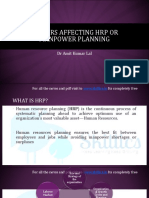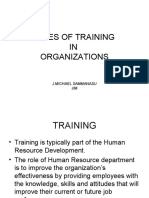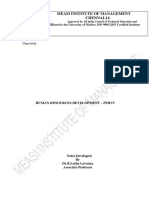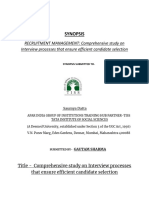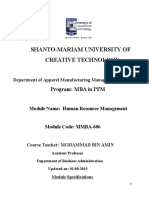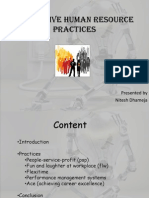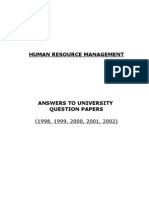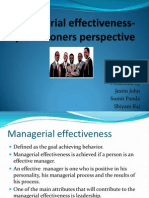Unit 1
Unit 1
Uploaded by
patil_viny1760Copyright:
Available Formats
Unit 1
Unit 1
Uploaded by
patil_viny1760Original Description:
Copyright
Available Formats
Share this document
Did you find this document useful?
Is this content inappropriate?
Copyright:
Available Formats
Unit 1
Unit 1
Uploaded by
patil_viny1760Copyright:
Available Formats
Manpower Planning and Resourcing
Unit 1
Unit 1
Manpower Planning
Structure 1.1 Introduction Objectives 1.2 Effective Manpower Planning 1.3 Need for Manpower Planning 1.4 Five Steps in Manpower Planning Evaluate Present Manpower Inventory Manpower Forecasting Develop a Manpower Sourcing Plan or Retrenchment Plan Manpower Allocation & Retention Building Requisite Competencies 1.5 Importance of Manpower Planning 1.6 Obstacles in Manpower Planning 1.7 Advantages of Manpower Planning 1.8 Successful Manpower Planning 1.9 Consolidated Demand Forecast Development 1.10 Effective Decision Making 1.11 Gaining Senior Management Support 1.12 Meeting the Organization's Goals and Objectives 1.13 Summary 1.14 Glossary 1.15 Terminal Questions 1.16 Answers
1.1 Introduction
According to Eric W. Vetter, manpower planning is a very vital process where the management determines how the organization should move from its present manpower position to a desired manpower position. According to Stainer, manpower planning may be defined as a strategy for the procurement, development, allocation and utilization of an enterprises human resources. We all know that organizations are made up of people. Manufacturing industries need people to operate machines, maintain machines and ensure desired output quality. Service industries need people to serve customers.
Sikkim Manipal University Page No.: 1
Manpower Planning and Resourcing
Unit 1
People are the most important part of any organization. It is the people working in an organization who individually and collectively contribute to the achievement of the business objectives. One cannot ever overstress the importance of people to make an organization successful. Manpower planning managers need to estimate the total number of resources required for each position or job role correctly. This is no easy task. If you are the manpower planning manager, you may not know so many things that will unfold over the course of the year at the beginning of the year like: How many people will get promoted? How many people will attrite? How many people are additionally required to expand the business? Which part of the business will grow by what percentage? Which part of the business will decline by what percentage? Which specific skills sets are going to be short in the market? Will the manpower budget be adequate? Manpower planning managers need to estimate the requirement as close to reality as possible and also ensure hiring for the job role requirements in the shortest possible time so that the business is not impacted negatively due to the shortage or absence of resources. And this is what makes manpower planning an interesting subject. Definitions According to K. F. Turkman manpower planning can be defined as an attempt to match the supply of people with the jobs available in an organization. Statistical techniques have been used to match the supply of people with the jobs available. Bruce Coleman has defined manpower planning has been defined as the process of determining manpower requirements and the means for meeting those requirements in order to carry out the integrated plan of the organization. The website www.businessdictionary.com defines manpower planning as: Estimating or projecting the number of personnel with different skills required over time or for a project, and detailing how and when they will be acquired.
Sikkim Manipal University
Page No.: 2
Manpower Planning and Resourcing
Unit 1
A business definition according to www.bnet.com for manpower planning is The development of strategies to match the supply of workers, and the availability of jobs at organizational, regional or national level. Objectives After studying this unit you will be able to: Describe the need for manpower planning State the steps in manpower planning Summarize the obstacles of manpower planning Recognize a consolidated demand forecast for manpower
1.2 Effective Manpower Planning
Effective manpower planning is hiring the right number of people and the right kind of people at the right place and at the right time for doing the right things. Effective manpower planning helps in achieving the goals and objectives of the organization. The concept of manpower implies that employees are resources for employers. Employees can also be called as human capital. In other words they add economic value to an organization. Whether an organization is manufacturing aeronautical equipment, or selling automobiles, textiles, cosmetics, footwear, computers, or the latest electrical gadgets, it needs manpower to be successful at whatever it is doing. Organizations need employees with a certain level of confidence, competence, training and expertise. Manpower cannot be easily replaced or substituted in any form or manner. Let me just pause here for a minute and ask a question. What is it that makes a human being unique? The answer is quite simple. It is because each person is an individual and no two people are the same, yes not even identical twins. They are also different. They are different in their outlook, their behavior, their thinking, creativity, motivation, enthusiasm, assertiveness, judgment, intelligence etc. Human beings alone have the ability to think, grow, feel, show pleasure at achievements, show displeasure or dissatisfaction etc. All other resources are passive and have no reactions.
Sikkim Manipal University
Page No.: 3
Manpower Planning and Resourcing
Unit 1
Therefore, effective manpower planning is hiring the right number of people and the right kind of people at the right place and at the right time for doing the right things.
1.3 Need for Manpower Planning
Every business requires investments of funds. The art of maximizing returns from such investments within the framework of law and ethics requires the right numbers of people are available for the open positions at the right time, at the right place with the right competencies, attitude and values for doing the right things. Imagine your business need 1000 people, and your business always has 300 less resources than required in most months. Will your organization be able to achieve the goals and objectives it set out at the beginning of the year? If it does not achieve the goals and objectives planned, it will not be able to generate the returns the management of the company has made to its shareholders or directors or investors. If the business is not able to build and maintain its credibility with various stakeholders, the business starts to fail. Similarly if your business needs 1000 people and your business is always overstaffed by 300 resources then the cost of the additional manpower, the infrastructure cost for the additional manpower and management costs for the additional manpower eats away into the profitability of the business, hence the need for manpower planning. Manpower planning is done to ensure the health of the business, credibility of the business and growth of the business. Manpower Planning is thus helpful to organization in the following manner: Shortages and surpluses can be identified so that quick action can be taken wherever required. All the recruitment and selection programs are based on manpower planning. It helps to reduce the labor cost too as excess staff can be identified and thereby overstaffing can be avoided. It also helps to identify the available talent in an organization and accordingly training programs can be drawn out to develop the talent required.
Sikkim Manipal University Page No.: 4
Manpower Planning and Resourcing
Unit 1
It helps in the growth and diversification of a firm or an organization. Through manpower planning, human re-sources/man/employees can be readily available and they can be utilized in the best manner. It helps the organization to realize the importance of manpower management which ultimately helps in the stability of an organization.
Self Assessment Questions 1. Manpower planning may be defined as a ____________ for the procurement, development, allocation and utilization of an enterprises human resources. 2. Effective manpower planning is hiring the right __________ of people and the right kind of people at the right place and at the right time for doing the right things.
1.4 Five Steps in Manpower Planning
Manpower planning requires that an estimate of the present and future needs of the organization should be compared with the available manpower and future predicted manpower. Appropriate steps are then taken to bring demand and supply into balance. The outcome of this planning is a well 'thought out' and logical manpower demand plan for varying dates in the future which can then be compared with the crude manpower supply schedules. The comparisons will then indicate what steps should be taken to achieve a balance. The 5 steps in the manpower planning process are: Evaluate present manpower inventory Manpower forecasting Develop a manpower sourcing plan or retrenchment plan Manpower allocation Building requisite competencies 1.4.1 Evaluate Present Manpower Inventory It is very important to evaluate the present manpower status before making a forecast for future manpower planning. To evaluate the present manpower status a department by department analysis and a job-role by job-role analysis is conducted to arrive at the required manpower versus the available manpower. This is accumulated across the organization at different levels and departments. The final report will consolidate and state the required manpower versus the available manpower in terms of the
Sikkim Manipal University Page No.: 5
Manpower Planning and Resourcing
Unit 1
quantitative analysis. Another analysis on the qualitative side conducted similarly shows the competencies required versus competencies available for each of the job roles. This provides the present manpower inventory. There may be excess or deficit or in extremely few cases just the right number quantitatively. The report on the qualitative front may rarely have a 100% match between required competencies versus available competencies. 1.4.2 Manpower Forecasting Manpower planning is done based on the manpower forecasts. The common manpower forecasting techniques are: (i) Expert Forecasts: This includes formal expert surveys, informal decisions and the Delphi technique. (ii) Trend Analysis: Manpower needs can be seen through the past practice of the firm or organization keeping the principle year as a basis and a central tendency of measure (iii) Work Load Evaluation: This depends on the nature of the work load in a branch, department, or a division in a firm or organization. (iv) Work Force Evaluation: As production and the time duration are to be kept in mind, allotments have to be made for getting the total manpower requirements. (v) Other Methods: A few mathematical models with the help of computers are also used to forecast manpower needs. You will learn more about forecasting in unit 2. 1.4.3 Develop a Manpower Sourcing Plan or Retrenchment Plan Once the current inventory is compared with the future manpower forecasts then the manpower sourcing or retrenchment plan is drawn. The sourcing plan includes recruitment, selection, placement, hiring temporary staff and outsourcing. You will learn more about the sourcing plan in unit 6. The retrenchment plan involves sending show-cause notices to bottom performers called bottom scraping, asking people to leave the organization by providing the requisite severance allowance, allowing employees to go on a sabbatical and finally out-placing employees in other organizations to reduce the manpower. It is harder to retrench manpower. The need for
Sikkim Manipal University Page No.: 6
Manpower Planning and Resourcing
Unit 1
retrenchment could also be minimized by very objectively approving any additional manpower. 1.4.4 Manpower Allocation & Retention Manpower allocation helps in managing the impact of deficits and excess in manpower supply through promotions, transfers and job-rotations. Enhancing manpower utilization requires managing the dynamics of leadership and motivation. Manpower retention would mean taking necessary steps to ensure that the organization provides a conducive-atmosphere to the employees to perform and keeps each employee engaged. 1.4.5 Building Requisite Competencies Once the future manpower forecasts are compared to the current inventory, there may be some gaps in competencies amongst the available internal resources for them to qualify for the future manpower forecasts. In such cases organizations may choose to develop resources through training programs. A training calendar is designed to ensure competencies of existing staff are enhanced to meet the future manpower forecasts. Additional training programs may be designed when organizations are diversifying or expanding. Training programs may be designed to train existing resources on the latest improvements and advancements in technology or the related business subject. Training is provided to improve the knowledge, skill and capability of the employee. Self Assessment Questions 3. Manpower allocation is a step in the __________ planning process. 4. Expert forecasts and trend analysis are two types of _____________ techniques. 5. ________ and ________ can be identified and quick action can be taken in planning. 6. Manpower planning reduces ______ costs as excess staff can be identified thereby avoid _______.
1.5 Importance of Manpower Planning
The main purpose of manpower planning is to increase the productivity of the organization and the total value created by the organization in a given unit of time. It could be a month, quarter, half year or the year. This enables
Sikkim Manipal University Page No.: 7
Manpower Planning and Resourcing
Unit 1
the business to become profitable and increases the profit margin. All the business plans can be achieved only by manpower planning. Else business plans will never turn into a reality. Manpower planning is done for: Successful execution of plans Efficient utilization of resources Motivating employees Better human relations Higher productivity
1.6 Obstacles in Manpower Planning
The major obstacles in manpower planning are as follows: Non Optimal Utilization of Manpower The biggest obstacle for manpower planning is the fact that organizations cannot optimally use their manpower once manpower planning begins. During manpower planning, the number of resources required for a job is decided based on the total work load, the process to be followed and the criticality of the job. Once the analysis is done, it is decided that one person can only handle a certain portion of the workload and hence for any additional workload, additional resources need to be hired proportionately. Over a period of time, the total workload may change, the processes may change, the criticality of the job may change and new technological innovations may make the job far easier to accomplish. However when the same employees are asked to step up the productivity, they resist accepting any additional workload and resist even deployment of new technology, hence making it hard for the management to maximize the use of their manpower. This makes the organizational processes ineffective or inefficient and hence the organization as a whole becomes ineffective or inefficient and loses out to competition which may be able to remain lean in terms of number of resources and highly effective and efficient. Absenteeism Every organization has witnessed an increase in absenteeism. This has lead to errors creeping in the manpower planning exercise. If the plan stated that 4 employees are required to manage the total workload, increased degree of absenteeism leads to the partial failure of the manpower planning exercise.
Sikkim Manipal University Page No.: 8
Manpower Planning and Resourcing
Unit 1
Lack of Employable Labor People are not employable. The slow pace of acquiring business required competencies by people at large also result in low employee productivity. All manpower planning is done basis a certain productivity level considered as a benchmark. And low productivity has negative implications for manpower planning. Modern Manpower Control and Review Processes Any increase in manpower is to be approved by the top most levels of the management today. Manpower budgets created on the basis of manpower planning act as control mechanisms to keep the manpower cost and headcount under certain defined limits. Usually the productivity of any organization is calculated using the formula: Productivity = Output / Input. Example: 5 products are sold during the day/ 8 hours of effort put in during the day. i.e., the sales productivity of the employee is 5 products per day. But a rough guide of employee productivity used today is: Employee Productivity = Total Production / Total no. of employees Example: 50 products are sold during the day/12 employees were responsible for selling 50 products during the day. i.e., the sales productivity of each employee is 4.17 products per day. The rate of manpower turnover, exit interviews and absenteeism are sources of measuring dissatisfaction level of manpower. To eliminate employee dissatisfaction and to ensure better utilization of resources a study of the reasons causing the dissatisfaction level is required. Overtime is paid to employees due to real shortage of manpower, inefficient management or improper utilization of manpower. Manpower planning requires a study of the overtime statistics.
The current pace at which business is done today is very fast. Many organizations either do not have data or are overwhelmed with data. Non availability and non utilization of the data are also reasons for complicating the situation. In some organization even the existing technologies available for manpower planning are not optimally used. This also creates obstacles in manpower planning.
Sikkim Manipal University Page No.: 9
Manpower Planning and Resourcing
Unit 1
Example: Business Scenario for Obstacles in Manpower Planning (Lack of employable labor) The entire BPO industry is suffering with this scenario of lack of employable labor. In a dynamic business scenario, manpower planning is critical to organizational growth and stability. It is integral to recruiting, retaining, retraining and redeployment of talent. Linked to business needs of the organization, the process of manpower planning is much more complicated than it seems. Manpower planning involves developing skills and competencies of existing employees to meet market demands which can change with time. Manpower planning also requires having a contingent plan in place in case of any eventuality (talent shortage). Out of every 100 candidates interviewed only 10 of them are employable. Majority of them are unemployable by the BPO industry. Its a known fact in the BPO industry. The manpower planning exercise requires BPO companies to budget for travel to the interiors of the state, travel to other states. It also needs to budget for providing new joiners with relocation allowance. It has to make provision for some joining bonuses as well when the hiring by all companies was at its peak. It decided to lower the level of hiring and spend additional time on training candidates. It needed to engage external organizations to evaluate the voice and accent capability or the potential of the candidate in order to validate its own findings with that of an independent agency, so that no potential candidate was rejected and no candidate who was not trainable was hired. The manpower planning required inclusion of non standard practices to ensure that the hiring targets were met so as to ensure that migration of client business processes from other countries to India was as per committed timelines. In fact some of the BPOs in India also have operations in countries like Philippines. Due to the inability of the India BPOs to hire in some cases, work is split up between India and Philippines.
Sikkim Manipal University
Page No.: 10
Manpower Planning and Resourcing
Unit 1
Activity 1: Meet 2-3 employees of 3 BPOs. Ask these employees how many times, they have been asked to work overtime. What kinds of incentives are offered to work over time? Do employees really like to work over time or would they prefer their weekends or holidays instead?
1.7 Advantages of Manpower Planning
Manpower planning ensures maximum utilization of available resources. It foresees not only the required number and type of employees, but it also determines a plan of action. The major advantages of manpower planning are: Optimum use of human resources currently employed. Reduced manpower costs. Drives optimal productivity of employees which is beneficial both for the organization and the nation at large. Keeps the business profitable and afloat. Provide controls to ensure necessary resources are available as and when required. Brings about fast economic developments. Ensures smooth organizational functioning post major expansion or retrenchment. Avoid build up of unnecessary employees and back up employees as there is a cost attached to manpower. Avoid unnecessary dismissals of employees. Helps in estimating salary costs and providing better benefits. Creates a healthy atmosphere of encouragement and motivation in the organization. Facilitates building competencies in the organization through training and development programs. Training activities becomes sharply focused. Enables employees to move to jobs for which their competencies are best suited. Creates a career path for employees to get promotions.
Sikkim Manipal University
Page No.: 11
Manpower Planning and Resourcing
Unit 1
1.8 Successful Manpower Planning
Successful manpower planning involves only two critical steps. 1. Estimating the demand forecast for manpower accurately 2. Ensuring the supply forecast for manpower meets the demand forecast Implementation of the five steps in manpower planning described in unit 1.4 in letter and spirit makes the manpower planning successful. Sometimes department managers or leaders wish to increase their span of control and hence they project a higher requirement for resources than required. They also undertake one time assignments that would require a higher requirement for resources. But on completion of the one-time assignment they do not let go of these additional resources. The personal benefit to the leader in the short term is that their CV becomes impressive due to the huge span of control but over the long term the organization needs to bear the consequences of living beyond its means. That means, the organization has a manpower bill which may be as high as 82% of its overall revenue. This is acceptable in any business because there are other costs apart from manpower costs and this would mean the business is making losses as the expenditure far exceeds revenues. Successful manpower planning is when the manpower costs are closely following industry benchmarks if not beating them. The outcome of successful manpower planning is all positions are filled as per the requirement plan. Self Assessment Questions 7. The main purpose of manpower planning is to increase the _________ of the organization and the total value created by the organization in a given unit of time. 8. Non Optimal Utilization of Manpower is one of the ______________ in manpower planning. 9. Optimum use of human resources currently employed is one of the major ______________ of manpower planning.
1.9 Consolidated Demand Forecast Development
The manpower planning function conducts an orientation program for the representatives of all the departments including the HR department. As per the guidelines issued, the representatives of the different departments
Sikkim Manipal University Page No.: 12
Manpower Planning and Resourcing
Unit 1
develop the manpower demand forecast. This demand forecast is then sent by the representatives of each of the departments to the department head for approval. The department ahead approves the demand forecast based on the business needs and the budgets available. The department head may consult the compensation and benefits team to understand the salaries or the cost to the company for employees at different levels. Once the department head approves the demand forecast which can be met from a budgetary perspective, then the demand forecasts are forwarded to the manpower planning function. The manpower planning functions consolidates the demand forecast for manpower received from different departments. Figure 1.1 illustrates the consolidated demand forecast development.
Fig. 1.1: Consolidated Demand Forecast Development
1.10 Effective Decision Making
The manpower planning exercise facilitates effective decision making to take place. All decision making becomes relatively easy when the relevant data is available. Analysis of the data itself provides inferences and guides the decision making process. The historical demand forecast and the supply forecast is reviewed apart from the forecast for the current period and the future. Learning from the previous manpower demand forecasting exercises are incorporated in generating the demand forecast for the current period and the future. Department representatives are sometimes asked to come back with a revised manpower demand forecast which needs to be about 20% lower
Sikkim Manipal University Page No.: 13
Manpower Planning and Resourcing
Unit 1
than the provided demand forecast. This forces the representatives to think out of the box to cut down the demand forecast. Usually this happens by departments identifying the non value-added tasks that were being performed by different people in the department. The processes are redrafted to eliminate non value-added tasks; this reduces the total workload across the department and hence allows for reduction of manpower demand forecast. Additionally some companies insist that the demand forecast should be provided month wise. Should the manpower not be recruited within that month or the quarter even when additional workload has been created, then those manpower requirements lapse. This is because the department has possibly found a way to work without the resource requirement forecasted earlier. In this manner, organizations ensure the actual manpower level remains lesser than the demand forecast levels if there is no negative impact to the business. We all would have heard that work stretches itself to fit into the available time frame. If a person is provided 20 minutes to send an email with some information, it is usually sent within 20 minutes. If a person is provided 1 day to send an email with some information, it usually is sent just 20 minutes before the 1 day ends. Therefore manpower planning exercises engage employees in some effective decision making for generating demand forecasts.
1.11 Gaining Senior Management Support
Sometimes the department representatives generate a demand forecast but do not have the underlying assumptions ready for discussion or have not generated the demand forecast by calculating the workload and hence the estimated time and resources required. When they seek an approval from the senior management to forward such a demand forecast to the manpower planning function, the department heads ask many questions. If the questions of the department head are not answered satisfactorily then the department head does not approve the demand forecast. In some other cases, the number of questions asked is so many and so fundamental that the representative along with the department managers may withdraw a part of the demand made initially.
Sikkim Manipal University Page No.: 14
Manpower Planning and Resourcing
Unit 1
Hence when generating a demand forecast each manpower requirement must be generated after due consideration to all possible questions that maybe asked. Proper justification can be kept ready for gaining the senior management support. Once the representatives undergo this exercise two or three times then it becomes easy to gain the support of the senior management because they understand the preparation required for generating the demand forecast for manpower.
1.12 Meeting the Organizations Goals and Objectives
All the checks and balances are built into the manpower planning process such that it enables the organization to meet its goals and objectives. The biggest enemy of a business is cost. However, every business needs to convert this enemy cost into their friend by being frugal, intelligent in designing processes with only value added activities, carefully in accepting responsibilities that fall outside the scope of their defined work. This does not mean that no will take responsibility for undertaking the out of scope task. It just means the clients will be approached and told that as per the contract signed with the organization; these tasks expected by them from the service provider are out of scope. They could be considered to be included in the scope for a consideration which will be treated as a new business opportunity and a fresh presentation will be made and quote provided for undertaking the activity. This ensures the clients do not receive any free services and the client is charged only for what they want. Its a win-win for both the client and the service providing organization. Both organizations are able to meet their respective goals and objectives. Activity 2: Read the article on manpower planning in railways written by Mr. M. K. Durgamani dated 26th April 2009, posted on the website www.articlesbase.com. Link http://www.articlesbase.com/human-resources-articles/manpowerplanning-in-indian-railways-886371.html. Self Assessment Questions 10. __________ generate the demand forecast based on the business need and the guidelines provided.
Sikkim Manipal University
Page No.: 15
Manpower Planning and Resourcing
Unit 1
1.13 Summary
Manpower planning is a very vital process where the management determines how the organization should move from its present manpower position to a desired manpower position. Manpower planning may be defined as a strategy for the procurement, development, allocation and utilization of an enterprises human resources. Human beings alone have the ability to think, grow, feel, show pleasure at achievements, show displeasure or dissatisfaction etc. There are five steps in the manpower planning process. They are: Evaluate present manpower inventory Manpower forecasting Develop a manpower sourcing plan or retrenchment plan Manpower allocation Building requisite competencies The main purpose of the manpower planning is to increase the productivity of the organization and the total value created by the organization in a given unit of time. The major obstacles in manpower planning are non optimal utilization of manpower; absenteeism; lack of employable labor; and modern manpower control and review processes. Successful manpower planning involves only two critical steps. Estimating the demand forecast for manpower accurately and ensuring that the supply forecast for manpower meets the demand forecast.
1.14 Glossary
Term Attrite Competency Description Employees leaving the organization are said to be attritions. Employees attrite from an organization. Competencies are the measurable or observable knowledge, skills, abilities, and behaviours (KSABs) critical to successfully perform a job. Estimate of expected demand for a product, service or resource over a specified future period. Forecasting is estimating the value of a variable/s at some future point in time. Page No.: 16
Demand Forecast Forecasting
Sikkim Manipal University
Manpower Planning and Resourcing
Unit 1
Manpower Inventory
The term inventory is often used in relation to counting of physical objects like raw materials, work in progress, finished products etc. It may also include the qualities and the abilities of persons working a company and is then called as manpower inventory. The process of acquisition of goods or services required for a company or a person is called procurement. A cutting down or cutting back of manpower in this context. Reduction of manpower in this context.
Procurement Retrenchment
1.15 Terminal Questions
1. 2. 3. 4. Explain effective manpower planning. Describe the 5 steps in manpower planning. List the obstacles in manpower planning. Highlight 4-5 key advantages of manpower planning
1.16 Answers
Answers to Self Assessment Questions 1. Strategy 2. Number 3. Manpower 4. Forecasting 5. Shortages, Surpluses 6. Labor, Overstaffing 7. Productivity 8. Obstacles 9. Advantages 10. Department representatives Answers to Terminal Questions 1. Refer section 1.2 2. Refer section 1.4 3. Refer section 1.6 4. Refer section 1.7
Sikkim Manipal University
Page No.: 17
Manpower Planning and Resourcing
Unit 1
Mini Case - Keeping Good People: Staffing Given the current labor market, the costs of recruiting and hiring are becoming more apparent than ever to organizations. After going through the difficulty of attracting and hiring talented people, businesses do not want to lose them to competitions. Difficulty is staffing has created an emphasis on retaining human resources. Applied Industries Technologies, a Cleveland-based business, has taken steps to reduce turnover. Specifically, they have made self-fulfillment - the process of helping each person reach their full potential - a central value in the organization. According to CEO John Dannemiller, the company views its self-fulfillment mission as important as salary and benefits in motivating talented employees. He attributes a doubling in revenues over the past eight years and a turnover rate below the industry average to self-fulfillment programs. Here is a summary of Applied Industrials self-fulfillment strategy: The company commits to 40 hours of training each year-a significant amount. Applied Industrial conducts regular leadership and personality testing. The test results are used to identify areas of personal improvement and to measure growth. The company offers reading lists of management books. Employees are reimbursed for education expenses. (Source: Dannemiller, J. C. (1998). How we keep good people. Across the Board, 35, 21.) Case Study Questions 1. Assume that you are Applied Industrial Technologies manager working to orient and hire new employees. a) How would you orient an employee who accepts a position at Applied but does not care about the self improvement program? So far, the employee has met job requirements but does not exceed higher than the job requirements. b) What steps could you take in selection to assess whether prospects would respond effectively to the self-fulfillment program? (Hint: As a start, consider individual characteristics that might affect a prospects response to this type of program).
Sikkim Manipal University
Page No.: 18
Manpower Planning and Resourcing
Unit 1
2. Applied Industrial views its self-fulfillment programs as a retention effort. It is also a recruitment tool? What, if any, do you think are the differences between tactics designed to improve retention versus those designed to improve attraction and recruitment? Hint: 1. a) By genuinely questioning how much am I interested in my personal and professional growth in terms of competencies, position and most of all the respect I get from all stakeholders. b) Hire people who are keen to learn. Their goal for learning should supersede their other goals. 2. Retention is attracting at an internal level, recruitment is attracting at an external level. Recommended Reading Prakash A. V. (2000). Manpower Planning and Development. India: ABD Publishers. Details of these books are available at www.sapnaonline.com and www.infibeam.com. References Books Rao S. P. (2010). Personnel and Human Resource Management. Mumbai: Himalaya Publishing House Tripathi P. C. (2009). Human Resource Development. New Delhi: Sultan Chand and Sons Mahapatro B. B. (2010). Human Resource Management. New Delhi: New Age International Publishers Aggarwala D. V., (2008) Manpower: Planning, Selection, Training and Development. India: Deep and Deep. E-references http://www.managementstudyguide.com/manpower-planning.htm (Retrieved on 13 May 2010) http://www.buzzle.com/editorials/9-12-2004-59200.asp (Retrieved on 13 May 2010) http://www.chrmglobal.com/Replies/1680/1/Manpower-planning.html (Retrieved on 13 May 2010)
Sikkim Manipal University
Page No.: 19
You might also like
- UNHCR Best Practice Interviewing GUIDE InterviewersDocument46 pagesUNHCR Best Practice Interviewing GUIDE Interviewersngaru83% (6)
- Mechanical Engineer CDRDocument14 pagesMechanical Engineer CDRBogdan Moldoveanu80% (5)
- Strategies For Designing The HRD ProgramDocument14 pagesStrategies For Designing The HRD ProgramVarsha AgarwalNo ratings yet
- Seminar On Performance Appraisal and Potential AppraisalDocument13 pagesSeminar On Performance Appraisal and Potential AppraisalTaran bolaNo ratings yet
- Amazon Leadership Principles: A Short GuideDocument17 pagesAmazon Leadership Principles: A Short GuideAbhishek Yadav100% (3)
- HR Policies of Standard Chartered: TopicDocument17 pagesHR Policies of Standard Chartered: Topiczuhairizvi0% (1)
- Critical Care NurseDocument11 pagesCritical Care NurseMohit ShuklaNo ratings yet
- HRMDocument3 pagesHRMMehedi HasanNo ratings yet
- Manpower PlanningDocument3 pagesManpower PlanningVatsal JariwalaNo ratings yet
- Biyani Bba HRD Notes PDFDocument57 pagesBiyani Bba HRD Notes PDFsunny rockyNo ratings yet
- Human Resource Development: Doms University of MadrasDocument239 pagesHuman Resource Development: Doms University of MadrasJaya Pradeep100% (1)
- Concept Note - L&DDocument2 pagesConcept Note - L&Dsmita75No ratings yet
- HRP Project Doc Full & FinalDocument14 pagesHRP Project Doc Full & FinalNikhil SinghaniaNo ratings yet
- HRM Lecture 1Document31 pagesHRM Lecture 1Latif Masih FAST NU LHRNo ratings yet
- Tcs T An DDocument21 pagesTcs T An DRamesh KrishnanNo ratings yet
- Role and Responsibility of Training ManagerDocument9 pagesRole and Responsibility of Training ManagerbekaluNo ratings yet
- Factors Affecting HRP or Manpower Planning: DR Amit Kumar LalDocument11 pagesFactors Affecting HRP or Manpower Planning: DR Amit Kumar Lalimdad ullahNo ratings yet
- Talent Management: Buket AkyelDocument33 pagesTalent Management: Buket AkyeldeviNo ratings yet
- Performance ManagmentDocument66 pagesPerformance ManagmentBir Betal MatketingNo ratings yet
- Nidhi HR Thesis 2Document83 pagesNidhi HR Thesis 2Bidisha BhattacharyaNo ratings yet
- Types of Training IN Organizations: J.Michael Sammanasu JIMDocument37 pagesTypes of Training IN Organizations: J.Michael Sammanasu JIMFaisal Shah100% (1)
- Human Rights & Development PDFDocument32 pagesHuman Rights & Development PDFnehaNo ratings yet
- CHP 3 Employee DevelopementDocument36 pagesCHP 3 Employee Developementmalik abdul munimNo ratings yet
- Macro Level Man Power PlanningDocument10 pagesMacro Level Man Power Planningsuvobroto banerjeeNo ratings yet
- Case Studies Mba 1 AssignmentDocument2 pagesCase Studies Mba 1 Assignmentayushi aggarwalNo ratings yet
- Differences Between Offensive and Defensive MarketingDocument3 pagesDifferences Between Offensive and Defensive Marketingsuhaspatel84No ratings yet
- POM (Staffing)Document33 pagesPOM (Staffing)ashik.m.ashrafNo ratings yet
- Human Resources Management.Document14 pagesHuman Resources Management.Bridget Smith100% (1)
- PMF15Document258 pagesPMF15hari100% (1)
- The Advantages of Employee Empowerment: Faster Problem SolvingDocument4 pagesThe Advantages of Employee Empowerment: Faster Problem SolvingBernadette loyolaNo ratings yet
- Soss Module PCL IDocument3 pagesSoss Module PCL Ijyotpreet_110No ratings yet
- Chapter 1Document41 pagesChapter 1Sabiha MirNo ratings yet
- Project ManagementDocument52 pagesProject ManagementAwot HaileslassieNo ratings yet
- Implementing HRD ProgramsDocument36 pagesImplementing HRD Programssuganyababumba100% (1)
- Nature & Scope of HRMDocument26 pagesNature & Scope of HRMhahire100% (3)
- Job Analysis and DesignDocument47 pagesJob Analysis and DesignfayazalamaligNo ratings yet
- Recruitment and Selection NotesDocument19 pagesRecruitment and Selection NotesKaran Ved0% (1)
- Numaligarh Refinery Limited Recruitment Rules For OfficersDocument18 pagesNumaligarh Refinery Limited Recruitment Rules For OfficersSatyen ChaturvediNo ratings yet
- Effectiveness of Performance Appraisal System in Pantaloons Retail India LimitedDocument21 pagesEffectiveness of Performance Appraisal System in Pantaloons Retail India LimitedBahavathi prakashNo ratings yet
- Managing Cultural Diversity - Implications For Organizational CompetitivenessDocument13 pagesManaging Cultural Diversity - Implications For Organizational CompetitivenessShabanaSaleem100% (3)
- Characteristics of Financial ServicesDocument10 pagesCharacteristics of Financial ServicesISHITA GROVERNo ratings yet
- Training GuideDocument17 pagesTraining GuideLakshay DhamijaNo ratings yet
- 3 Job AnalysisDocument31 pages3 Job AnalysisFaisal MalekNo ratings yet
- E-HRM - Paper Presentation EbstudiesDocument9 pagesE-HRM - Paper Presentation EbstudiesChintan P. ModiNo ratings yet
- Recruitment Management: Importance of Recruitment & Selection in An OrganizationDocument7 pagesRecruitment Management: Importance of Recruitment & Selection in An OrganizationGautam SharmaNo ratings yet
- Techniques For Forecasting Human ResourcesDocument10 pagesTechniques For Forecasting Human Resourcesarchanashri2748No ratings yet
- Organisational BehaviourDocument5 pagesOrganisational BehaviourSnehal Nayak67% (3)
- Notes On StaffingDocument61 pagesNotes On StaffingDrRam Singh KambojNo ratings yet
- CBHRM NotesDocument8 pagesCBHRM NotesVipul PatilNo ratings yet
- MMBA-606 Human Resource ManagementDocument155 pagesMMBA-606 Human Resource ManagementDeluar HossainNo ratings yet
- Appraising The Secretaries at Sweetwater U-Case 9Document2 pagesAppraising The Secretaries at Sweetwater U-Case 9Anh ThyNo ratings yet
- Talent Management ProcessDocument2 pagesTalent Management ProcessRanjana BandaraNo ratings yet
- Human Resource PlanningDocument54 pagesHuman Resource Planningrony100% (1)
- Innovative Human Resource PracticesDocument19 pagesInnovative Human Resource PracticesShatrughan Singh RaghuvanshiNo ratings yet
- Values & Ethics - POMDocument16 pagesValues & Ethics - POMNirmal100% (1)
- Project Review and Administrative AspectsDocument8 pagesProject Review and Administrative Aspectsamitsingla19No ratings yet
- Syllabus Bolton UniversityDocument5 pagesSyllabus Bolton UniversityPhuongChiNo ratings yet
- CASE STUDY-Performance Appraisal - ShreyasiDocument3 pagesCASE STUDY-Performance Appraisal - ShreyasiShreyasi ChaudhuriNo ratings yet
- HRD RoiDocument19 pagesHRD RoiRakshana SrikanthNo ratings yet
- Unit 8 Human Resources Learning Aim AB Assignment BriefDocument3 pagesUnit 8 Human Resources Learning Aim AB Assignment BriefFilip AntonijevicNo ratings yet
- Step 1: Fully Engage Your Stakeholders. There Are Many Stakeholders in Succession PlanningDocument4 pagesStep 1: Fully Engage Your Stakeholders. There Are Many Stakeholders in Succession PlanningIrish GarciaNo ratings yet
- SA Syl12 Jun2014 P10 PDFDocument21 pagesSA Syl12 Jun2014 P10 PDFpatil_viny1760No ratings yet
- MB0034 Model Question Paper With Answer KeysDocument17 pagesMB0034 Model Question Paper With Answer Keyspatil_viny1760No ratings yet
- SMU Spring 2010 Second Semester Assignment Complete SetDocument180 pagesSMU Spring 2010 Second Semester Assignment Complete SetAnandarajeshwaran.JNo ratings yet
- 24 Income Tax GuideDocument7 pages24 Income Tax GuidePiyush KumarNo ratings yet
- BM Prelim TestDocument59 pagesBM Prelim TestME ValleserNo ratings yet
- Oap NC IiDocument92 pagesOap NC IiagnesNo ratings yet
- Selective Hiring: Hiring The Right People: Southwest Airlines Hire For Attitude, Train For SkillDocument2 pagesSelective Hiring: Hiring The Right People: Southwest Airlines Hire For Attitude, Train For SkillaatishNo ratings yet
- HR Summer Internship ProjectDocument66 pagesHR Summer Internship ProjectSahil BansalNo ratings yet
- Supervisory Management - Planning and ControlDocument9 pagesSupervisory Management - Planning and ControlArilesere SodeeqNo ratings yet
- HRM NotesDocument70 pagesHRM Noteswelcome2jungle84% (25)
- TR Masonry NC IDocument54 pagesTR Masonry NC Ichristopher peraterNo ratings yet
- Social and Emotional Development Observation FormDocument6 pagesSocial and Emotional Development Observation FormCSYSNo ratings yet
- Evaluating Community Health Nursing ServicesDocument20 pagesEvaluating Community Health Nursing ServicesJohn Mark Alvin Torres100% (1)
- TR - Plumbing NC IDocument80 pagesTR - Plumbing NC IdyllanNo ratings yet
- 5 Steps To Practically Implement AI Techniques: Key ChallengesDocument17 pages5 Steps To Practically Implement AI Techniques: Key ChallengesBill PetrieNo ratings yet
- Designing An Effective Training & Development Program of HSBC BankDocument26 pagesDesigning An Effective Training & Development Program of HSBC BankShahriar SakibNo ratings yet
- EOS Purchasing Operations Coordination Level IVDocument62 pagesEOS Purchasing Operations Coordination Level IVmesitom67% (3)
- IMS Internal Audit ModuleDocument12 pagesIMS Internal Audit ModuleashuchemNo ratings yet
- Managerial EffectivenessDocument17 pagesManagerial EffectivenessSumit PandaNo ratings yet
- HRMDocument33 pagesHRMJasim BalochNo ratings yet
- Bandung City Manager & Expansion - Job DescriptionDocument2 pagesBandung City Manager & Expansion - Job DescriptionandindNo ratings yet
- Methodology of Curriculum Development in Vocational Education and Training and Adult EducationDocument45 pagesMethodology of Curriculum Development in Vocational Education and Training and Adult EducationPhạm Thị Lệ QuyênNo ratings yet
- Defining, Teaching, Evaluating Cultural Proficiency in The Foreign Language ClassroomDocument12 pagesDefining, Teaching, Evaluating Cultural Proficiency in The Foreign Language ClassroomNada SalihNo ratings yet
- Orchid Ecotel Case Analysis - Group 2IDocument9 pagesOrchid Ecotel Case Analysis - Group 2IRishabh KothariNo ratings yet
- Job Description of Research AssociateDocument2 pagesJob Description of Research AssociatejsmnjasminesNo ratings yet
- Coach Others in Job Skills 310812Document117 pagesCoach Others in Job Skills 310812Nga NguyenNo ratings yet
- Interpersonal: Communication Symptoms of DeficiencyDocument28 pagesInterpersonal: Communication Symptoms of Deficiencyejazdar89No ratings yet
- Answer:: Name: MD - Thoufiqur Rahman ID: 19-99599-3 Sec: A EmbaDocument19 pagesAnswer:: Name: MD - Thoufiqur Rahman ID: 19-99599-3 Sec: A EmbaLikhon RahmanNo ratings yet
- Definitions of CompetenceDocument5 pagesDefinitions of CompetenceVinoy MedhiNo ratings yet
















